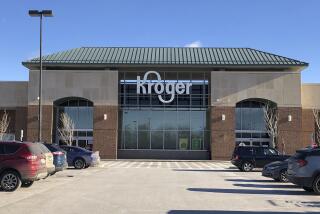Costs of Dispute Hang Over Grocers
Like a carton of milk left too long in the sun, the finances and reputations of participants in the Great Grocery Strike of 2003-04 continue to curdle, six months after the dispute ended.
The reason the conflict lasted so long, shoppers will recall, is that Safeway Inc. (owner of Vons and Pavilions), Kroger Co. (owner of Ralphs), and Albertsons Inc. decided they were in a mortal struggle with Wal-Mart Stores Inc. and its peculiar wage structure, which seems to be based on sharing its payroll costs with public assistance agencies. So they refused to negotiate for months.
Throw in local union leaders who were shocked to learn that they weren’t dealing with mom-and-pop grocery owners, but hard-bitten corporate suits, and the result was 4 1/2 months of joblessness for 59,000 workers.
It’s plain that union members lost much in the settlement. They staved off some of management’s more draconian proposals, but they agreed to a two-tier wage and benefits system that ensures no one will ever again be able to support his or her family in a grocery career.
But the companies shouldn’t be celebrating, either. Their latest financial reports haven’t made pretty reading. Safeway, the strike’s main target, acknowledges forgoing about $275 million in profits -- including lost sales and the cost of shopper-luring bargains -- in the nine months since the labor unrest began last October.
Safeway Chairman Steve Burd used to contend that the union’s contract demands would have cost his company about $130 million over its three-year term. In the last nine months, then, the strike looks to have cost his company more than twice the price of full capitulation. Can Burd still claim that playing hardball was the right approach?
The costs at Kroger and Albertsons, which locked out their workers in sympathy with Safeway, were similar -- profits erased to the tune of $227 million at the former and $187 million at the latter.
This outcome could be justified if it led to better results down the road, say by reducing labor costs across the board. But there’s scant evidence so far that unions elsewhere are willing to accept the concessions asked of the Southern California locals. Wall Street certainly isn’t bidding up these stocks in anticipation of bright days ahead: They’re all down sharply since the strike’s end, with Kroger and Safeway both outpacing the broad market’s decline.
In any event, dollars don’t tell the whole story. While fixing their eyes on Wal-Mart, the chains unwittingly exposed their backs to another formidable rival: Costco Wholesale Corp.
Costco reported that its same-store sales soared 11% after the strike began, and they’ve stayed at that level. “This was a watershed event for Costco,” says Gary Giblen, director of research at C.L. King & Associates in New York. “They’ve retained 100% of that volume.”
Giblen believes that many grocery shoppers fleeing the strike discovered that Costco offers better-quality perishables than their supermarkets, at lower prices. Evidently, this has been enough to overcome any resistance to Costco’s $45 annual fee and its bare-bones ambience.
Although other chains also picked up sales, the Costco surge suggests how the three chains may have miscalculated in prolonging the strike. Indeed, Costco could represent an even graver threat than Wal-Mart to the conventional groceries’ market shares in California.
For one thing, it’s already solidly ensconced statewide. Wal-Mart plans to open 40 California Supercenters with grocery departments over the next five years or so, but Costco already has 100 locations. It’s likely to have an easier time expanding, too, because Costco doesn’t inspire the intense communal hostility often aimed at Wal-Mart.
One other strike cost that hasn’t been widely counted is the damage wrought on the companies’ public image. Executives insist that their employee morale and customer satisfaction ratings are rebounding to pre-strike levels. But that’s not the story one hears uniformly from employees. Nor does it square with the defection of thousands of once-loyal customers -- infidelity that is now showing up on the bottom line.
The worst blow to reputation may well fall on Ralphs. Just last week, the company acknowledged the truth of union allegations that it had quietly rehired many locked-out employees during the dispute, in violation of corporate policy and possibly of federal labor law. (It hasn’t admitted a related allegation that it hired some people under false names and Social Security numbers.)
The company blames a handful of store managers and local supervisors, several of whom have been suspended. One source close to the company’s internal inquiry describes many of the rehirings as “humanitarian” acts by store managers who referred a few of their own particularly needy employees to colleagues running other stores.
But the source also acknowledges that the union’s decision to withdraw its pickets from Ralphs stores midway through the strike meant the company needed to hire lots of workers. Whether higher-ups were truly unaware of how their underlings met their staffing needs, or whether they winked at an open secret, is a question that may be answered by the National Labor Relations Board or the U.S. attorney’s office in Los Angeles. Both are pondering whether to pursue the matter.
Legal experts say the worst outcome for Ralphs would be for the NLRB to declare the entire lockout illegal and order months of back wages for 20,000 workers. By my back-of-the-envelope calculation, that could total more than $80 million -- just another debit entry in one of the most misbegotten adventures ever in California labor relations.
Golden State appears every Monday and Thursday. You can reach Michael Hiltzik at golden.state@latimes.com.
More to Read
Inside the business of entertainment
The Wide Shot brings you news, analysis and insights on everything from streaming wars to production — and what it all means for the future.
You may occasionally receive promotional content from the Los Angeles Times.











